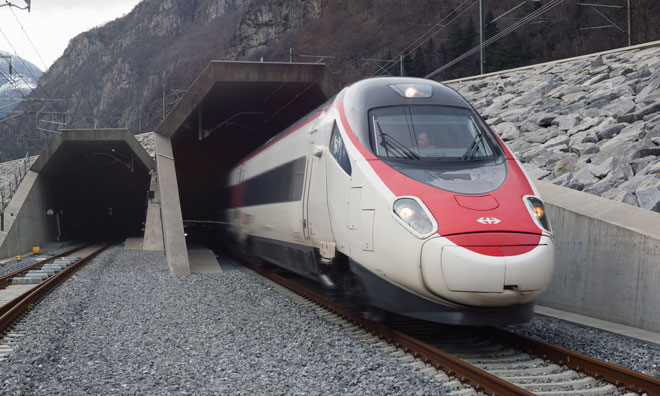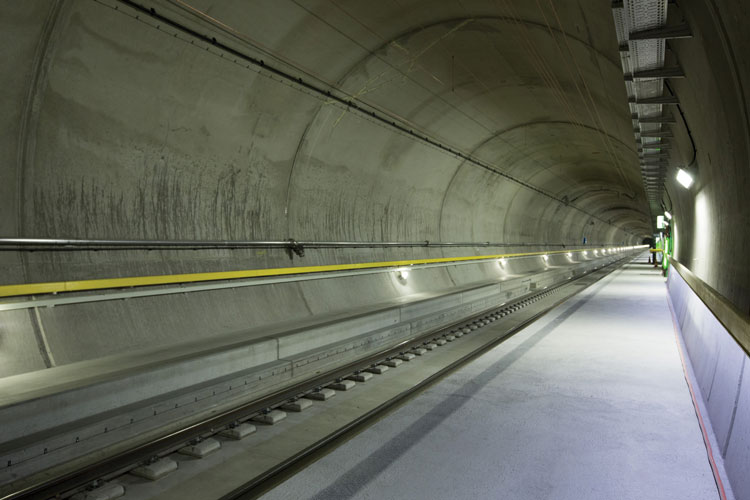Gotthard Base Tunnel – the longest rail tunnel in the world
Posted: 25 July 2016 | Philippe Gauderon | No comments yet
On 1 June 2016 an exciting new chapter was added to the Gotthard story. With the opening of the Gotthard Base Tunnel, Switzerland made railway history with a once-in-a-century construction project that embodies the innovation and competitiveness that makes the country the envy of Europe. For European Railway Review Head of SBB Infrastructure, Philippe Gauderon, reflects on this major project and highlights the benefits renewed passenger and freight operations will bring to the Gotthard region.


The new Gotthard Base Tunnel is the longest rail tunnel in the world at 57km and is emblematic of Switzerland’s pioneering spirit which remains bright even 100 years after the construction of the Gotthard mountain route. Swiss Federal Railways (SBB) is proud to operate the longest railway tunnel in the world. The once-in-a-century construction project illustrates the value of cooperation and reliability at all levels, from the electorate and politicians to public officials and industry representatives.
Greater capacity and efficiency thanks to the new flat-rail freight route
When it comes to freight traffic, the new Gotthard tunnel will bring increased capacity, faster services, lower production costs and greater reliability. Meanwhile, customers will receive efficient, congestion-free and environmentally-friendly solutions for their logistics requirements. From the 2016/2017 timetable change onward, four freight trains will travel through the tunnel every hour in each direction. Heavily-used service points in Ticino will receive up to three deliveries and collections a day. Also, for the first time, Ticino will be connected to western Switzerland by an overnight service enabling evening container drop-offs in Ticino and arrivals in Romandy by the morning.
For international transit traffic the new Gotthard Base Tunnel marks the first major step towards a flat-rail route through the Alps. With the Ceneri Base Tunnel and the four-metre corridor that enables the transporting of four-metre-tall semitrailers by rail, railway services will become significantly more competitive on the Gotthard axis. The Gotthard Base Tunnel will then be able to accommodate up to six freight trains – equivalent to a daily capacity of 260 trains – which represents a 44% increase on current throughput.
The Gotthard Base Tunnel will therefore contribute significantly to the road-to-rail transfer of freight traffic, allowing it to help protect the Alpine region.
Travel times reduced by approximately 45 minutes
Faster, more frequent and more convenient services, as well as new, modernised rolling stock will considerably increase the quality of passenger services. The improvements will take effect gradually from 2016 and provide their full benefit from the end of 2020. From the end of 2016 the trip from Zurich to Lugano will be 30 minutes shorter, while from the end of 2020 travel times between German-speaking Switzerland and Ticino will be reduced by approximately 45 minutes. In addition to more frequent long-distance services, regional traffic in Ticino will increase, in particular, and the lines between Lugano, Bellinzona and Locarno will be upgraded from the end of 2020, thus considerably reducing travel times.
SBB will continue to operate the historic mountain route, which is popular with tourists, giving the tourism industry in the Gotthard region a major boost.
A modern Traffic Management System for the world’s longest tunnel
In order to implement this transport concept, a modern Traffic Management System is required for the north and south access routes. The Traffic Management System used by SBB is the so-called Rail Control System (RCS) which will monitor all rail traffic on the SBB track network. Furthermore, SBB will control and monitor the rail operations in Ticino and to and from Arth-Goldau from its Southern train-control centre in Pollegio. Thanks to the RCS, from late-2020 SBB will be able to accommodate up to 330 trains a day in the world’s longest railway tunnel. Passenger information during service disruptions will also be issued from the Southern train-control centre and from summer 2016, the centre’s 160 employees will be able to monitor and control safety systems and the rail power supply of the Gotthard Base Tunnel.


A modern scheduling system is needed for the world’s longest railway tunnel which will be monitored by control centre employees
The rail operation in the new Gotthard tunnel must be managed using a sophisticated system; the greater the difference in speed between freight and passenger trains on a specific route, the lower the potential capacity. From 2020 the Gotthard Base Tunnel must be able to accommodate six freight trains and two passenger trains per hour in each direction. As a result, passenger trains will travel at up to 200km/h while freight trains will travel at a minimum of 100km/h. At speeds of 200km/h it takes just 17 minutes to pass through the longest tunnel in the world. Two groups of three freight trains will travel through the tunnel every hour in each direction, meaning all the trains in a group will pass through the tunnel at three-minute intervals. At the tunnel entrances in Erstfeld and Biasca, the freight trains will leave the main route to allow any passenger trains approaching from behind to overtake them.
A comprehensive safety concept
As a prerequisite for these processes, the modern cab signalling system – ETCS (European Train Control System) Level 2 – must be installed on the Base Tunnel’s direct approach routes: the Brunnen–Erstfeld route in the north and the Castione–Pollegio route in the south. ETCS Level 2 represents the next generation in train controlling and continually transmits the train’s speed and route data to the engine driver. If the driver fails to observe the legal speed limit, brake on time or stop when signalled, an automatic ‘train-stop’ function will engage.
The Gotthard Base Tunnel also features state-of-the-art safety systems to protect passengers, staff and tunnel workers. There are cross-passages into the adjacent tunnel tube every 325m which guarantees fast access to a safe area. Emergency lighting, handrails and signs help passengers to find their way to safety. In case of emergencies there is a fire-fighting and rescue train at each of the newly developed maintenance and intervention centres in Erstfeld and Biasca. These will ensure that help is only ever 45 minutes away, allowing affected passengers to be evacuated from the tunnel in 90 minutes. A range of wayside train monitoring systems installed on the tunnel access routes allow any train defects to be detected early, before the trains enter the tunnel.
The new Gotthard tunnel doesn’t just need to be operational by the end of 2016; it must also be maintained to the best possible standard. Given the tunnel’s length and complexity, this presents quite a challenge. The newly developed maintenance and intervention centres in Erstfeld and Biasca will offer a new point of departure for maintenance crews. Approximately 150 maintenance and intervention staff are employed for this service and have access to 31 new maintenance vehicles. Maintenance work is typically carried out over a three-night period: one tunnel tube is closed to commercial operations for eight hours overnight on Saturday/Sunday and Sunday/Monday, and for six hours overnight on Monday/Tuesday. For service disruptions that don’t require immediate attention, a so-called ‘joker interval’ can be imposed for the other four days, during which a third of the tunnel tubes will be closed. For service disruptions that must be dealt with immediately, (e.g. in the event of damage to the contact line), a 24-hour on-call service is available.


The Gotthard Base Tunnel will deliver greater capacity and efficiency for passengers and freight
Technology and systems only work as well as the people operating them. As a result, people remain crucial to the successful launch of the Gotthard Base Tunnel; a motivated workforce that is prepared to tackle new challenges is essential. For this reason, SBB spent two years before the launch of the Gotthard Base Tunnel training 2,900 SBB employees; 200 workers from other rail companies; and 800 external rescue teams. The training was offered to operational managers, drivers and train crews, maintenance and intervention workers.
When it opened on 1 June 2016, ownership of the Gotthard Base Tunnel was transferred from the construction company Alptransit Gotthard AG to SBB. This date also marked the start of a so-called trial operation during which SBB put the tunnel through its paces. It is currently practising coordinated operational processes in operations, intervention and maintenance, and is also completing trial runs with commercial freight and passenger vehicles. The trial operation is, therefore, the phase in which all of the elements prepared over recent years have to work seamlessly to ensure that the world’s longest rail tunnel has a successful and reliable launch on 11 December 2016.
Biography
Philippe Gauderon has been Head of SBB Infrastructure and a Member of the Management Board since 2009. He has been at SBB since 1996 leading the SBB Passenger Operating Division from 2003 to 2008 and acting as Deputy Head of Division. Before that Philippe was the Head of Regional Services and the Regional Director for Lausanne. From 1990 to 1995 he was Deputy Director of the Federal Office of Transport (FOT).








